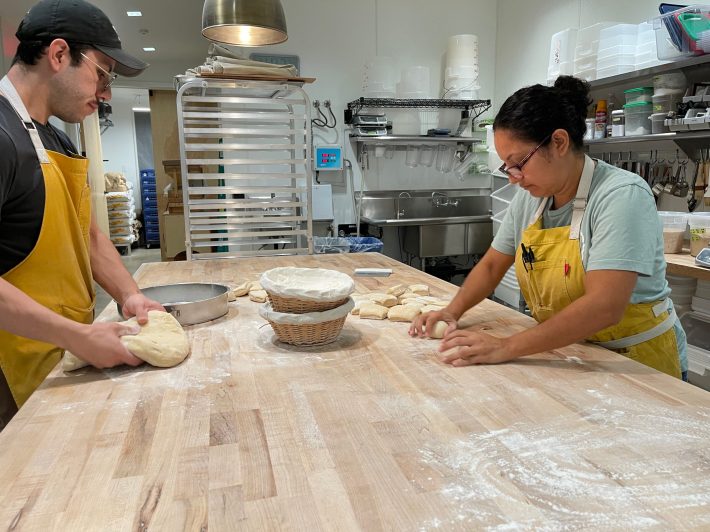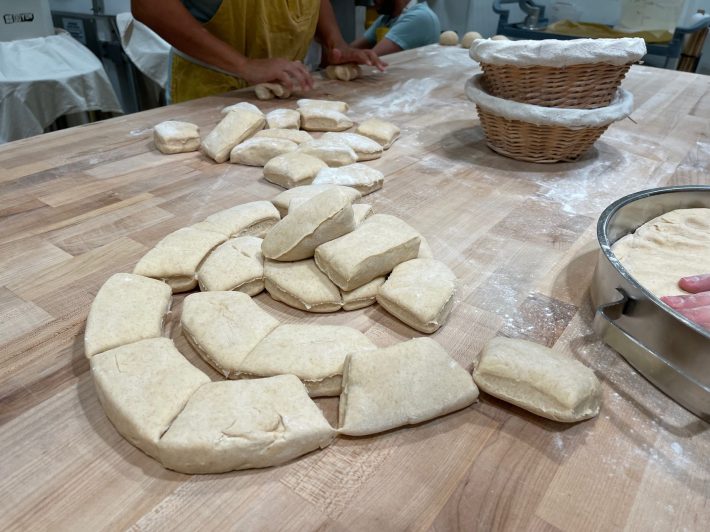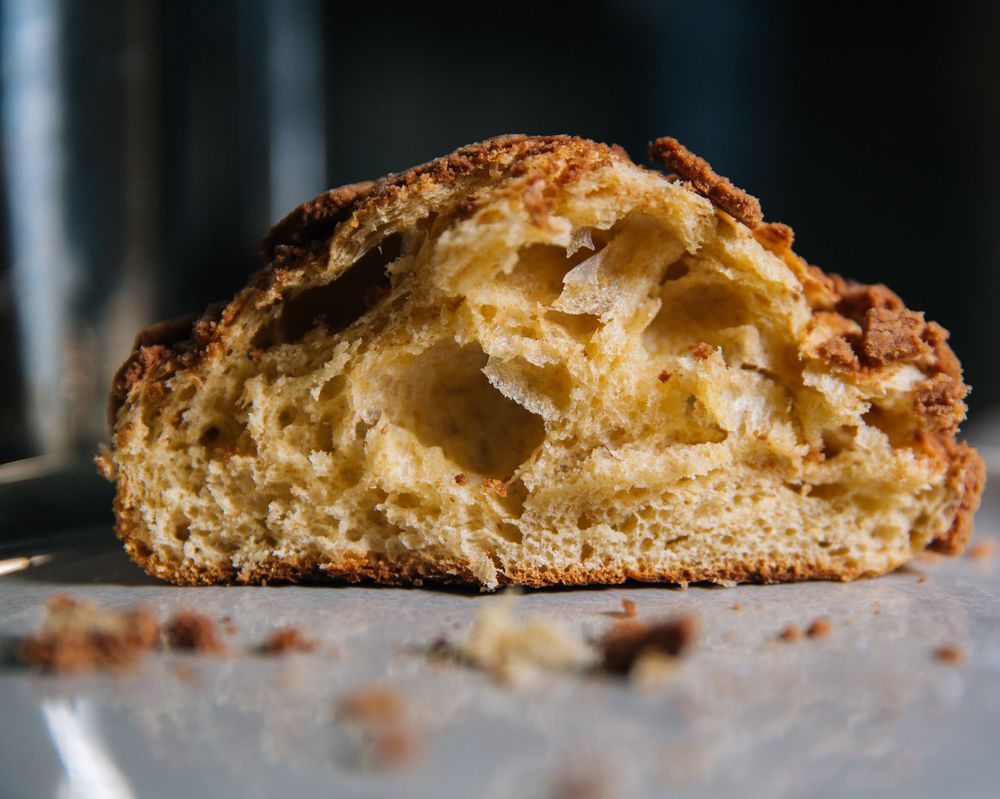The days at Gusto start at 4 a.m. sharp.
To celebrate this Sunday’s two-year anniversary of Arturo Enciso and Ana Belen Salatino’s brick-and-mortar bakery, I asked them if I could humbly shadow their bakers as they rose up many hours before the crack of dawn to make the independently owned shop’s sourdough conchas. They sell out, dozens of conchas at $5 each regularly; and more than a hundred on weekdays.
As a writer, there comes a time when simply eating and writing about a dish you love isn’t enough. I wanted to rise early in the morning, along with the conchas, and get to know them from the other side of the bakery case.
As a non-morning person, I’ve never envied the life of a panadero (baker). But it is almost worth it to tap into that zen-like state that can only be achieved when you get up at that ungodly twilight hour.
The concha is almost half sourdough. The other half made from a nearly all-organic base: flours, evaporated cane juice, eggs purchased weekly from La Bahn Ranch at the Torrance Farmers Market, and European Plugra butter. The dough was made and pre-fermented two days prior to being baked. The dough rests and then is mixed the day after. On the third day, they are shaped and baked.
By 4:03 a.m. today, Gusto’s pastry baker, Allec Cortez, was placing the refrigerated concha top in the proofer to get it to be at room temperature. It is equal parts ground cacao, butter, and sugar. By 4:10 a.m. Cortez and production lead baker Stephanie Shaw were already slicing the conchas, topping them with that now-room-temp buttery cacao top, shaping them with a kaiser roll stamp, and sliding the trays into the proofer, where they proof for about two hours before baking. In less than 20 minutes, the conchas are prepped for the day. Meanwhile, Ravi Hernandez, Gusto’s bread baker, is already deep into firing up the rustic loaves for the day; some were completely covered in sunflower seeds, others made with semolina.
When asked the ubiquitous question, “do you still love conchas?,” to both bakers, Stephanie responded immediately:
“Oh yeah. I used to eat them every day, and now I just make myself little ones from the scraps.”


Cortez now opts for Gusto’s savory, cheese-topped bolillo when hunger pangs come calling.
Enciso just finished strangling his two-year-old starter because he thinks that the hundred-year sourdoughs being touted at bakeries make more sense for romantic marketing rather than for better flavor in the final product, but that is a whole other story. He’s killed six of his sourdough darlings since 2013 and has no regrets.
The inspiration for Gusto’sconcha, as self-taught Enciso loves to recite, comes from making his best attempt to nail down what a concha tasted like a hundred years ago.
“Sourdough culture is kind of lost knowledge,” he said. “I wanted to unveil and explore that.”
Enciso’s conchas are naturally leavened with a week-old sourdough starter he created at Gusto, made from a handful of Valle de Guadalupe grapes he put in his shirt pocket. Grapes are full of wild yeasts, making them easy to harbor and grow.
Enciso and Salatino, his partner in life and business, jokingly referred to bread yeast powders as “magic sauce,” since adding them to dough makes the baking process a lot easier. As opposed to feeling your way through a new starter’s spontaneous flavors, a trial-and-error process that can take years to gain confidence in.
“Isolated powder yeasts only became conventional in the early 1900s,” Enciso said philosophically, on his second cup of strong, pre-7am coffee “Before that, bakers collected yeast from brewers, actually.”
Enciso just finished strangling his two-year-old starter because he thinks that the hundred-year sourdoughs being touted at bakeries make more sense for romantic marketing rather than for better flavor in the final product, but that is a whole other story. He’s killed six of his sourdough darlings since 2013 and has no regrets.
Nostalgia-driven concha addicts may be shocked to know that many of their favorite mom-and-pop panaderías make theirs with questionable dough conditioners. These are known as “mejorantes” in the Mexican baking industry and are banned in countries like Europe for being unsafe to eat. These magical bread powders add volume and allow the bread to stay as soft as long as possible.
I’ve eaten more than two dozen of Gusto’s conchas since moving to Long Beach, and it is a different experience nearly every time. The evolution of flavor and texture is why anything made with sourdough is so exciting. Today, the crumb of the concha was extra tender and riddled with a universe of air bubbles, each one dotted with barely visible microcosms of cracked grain. These conchas fill you up and keep you going all morning.
It’s important to recognize that Mexico’s pan dulce culture did indeed descend after the European conquest of the country. The earliest documented pan dulce goes back to the 1700s, created by Italian and French colonizers who settled in Mexico. But it took a couple hundred years more to fully convince the mostly Indigenous Mexicans at the time to give wheat-based bread a chance.
European bakers did this by adding sugar to bread, creating a pan dulce culture for many generations to come. Before this, Mexican populations subsisted on domesticated maize and amaranth for their grain intake. It wasn’t until the mid-1800s and early 1900s when pan dulce went mainstream, turning panaderías into an everyday part of life in Mexico, mostly enjoyed over breakfast with café de olla or in an afternoon or nighttime merienda next to a clay mug of drinking chocolate.
Enciso’s version is an experiment in trying to bring conchas back to that primitive, O.G. state, where a concha was maybe a little denser, but only because it was made with whole wheat and not containing as much sugar as it did in the days when it was a luxury and not an everyday ingredient.
I’ve eaten more than two dozen of Gusto’s conchas since moving to Long Beach, and it is a different experience nearly every time. The evolution of flavor and texture is why anything made with sourdough is so exciting. Today, the crumb of the concha was extra tender and riddled with a universe of air bubbles, each one dotted with barely visible microcosms of cracked grain. These conchas fill you up and keep you going all morning.
Most fascinating, there’s a slightly tart flavor that always lets itself be known as soon as you bite into it, especially when paired with a light-roast. Fresh out of the oven, the cacao coat is extra crunchy, turning instantly soft the second it's dunked into Gusto’s iced “oatxata.”
If you prefer a sweeter and more decadent variation on the concha, their cutely named “doñas” are day-old conchas that come filled with seasonal jams like guava or peach with strawberry with xoconostle (sour cactus fruit), then baked again, so the concha becomes extra crispy.
Gusto is no stranger to media obsession; a recent write-up by New York Times California Critic Tejal Rao brilliantly penned how Enciso and Salatino work tirelessly to cut the cord from pan dulce’s Eurocentric origins.
When the final tray is out of the oven, Enciso, all these years later after starting their cottage bakery at home in 2017, still tears into his own freshly baked conchas and takes the biggest bites imaginable of his creation. “Every single time we put out a concha, we are still so proud of them,” he says. “Every single one. They are everyone’s favorite. It’s our bread that brings everyone together.”
2710 E. 4th St. Long Beach, 90814. Gusto Bread’s two-year anniversary is this Sunday. There will be cake (while supplies last) and a birthday raffle. Closest transit lines: Long Beach Transit Line 151 - "4th/Temple", Long Beach Transit Lines 91, 92, 93, and 94 - "7th/Temple."







